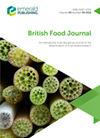消费者对餐厅菜单上食品过敏原信息的视觉注意力:一项眼动追踪研究
IF 3.4
3区 经济学
Q1 AGRICULTURAL ECONOMICS & POLICY
引用次数: 0
摘要
目的 本研究旨在了解 34 名食物过敏症参与者对哪种食物过敏原标签系统(非指导性、半指导性和指导性)的关注和偏好,以及他们对餐厅在菜单上标识食物过敏原的企业社会责任(CSR)和行为意向的认知。本研究利用单向重复测量方差分析(RM-ANOVA)和热图来分析参与者的菜单阅读行为。研究还对调查回答进行了内容分析,并对菜单进行了排序分析,以了解消费者偏好菜单设计背后的原因。参与者识别食物过敏原信息的速度在指令性标签系统(图标)中明显快于其他两种系统,这意味着它们很醒目。半指导性标示系统(红色文字)的访问次数较少,但比其他两种系统更受青睐;每种标示系统都有其优点和局限性。参与者认为在菜单上公布食物过敏原信息的餐馆具有社会责任感,他们今后会再次光顾这些餐馆。三角测量法的使用增强了研究结果的可信度。这项研究为美国的餐馆老板提供了有关餐馆菜单上食品过敏原标识价值的经验数据,尽管这种标识是自愿性的。本文章由计算机程序翻译,如有差异,请以英文原文为准。
Consumer visual attention to food allergen information on restaurant menus: an eye-tracking study
PurposeThis study sought to understand which food allergen labeling systems (non-directive, semi-directive, and directive) were attended to and preferred by 34 participants with food hypersensitivity and their perceived corporate social responsibility (CSR) and behavioral intention towards a restaurant that identifies food allergens on menus.Design/methodology/approachThis study used an online survey with open-ended and ranking questions, combined with eye-tracking technology, to explore participants' visual attention and design preferences regarding four menus. This study utilized one-way repeated measures analysis of variance (RM-ANOVA) and heat maps to analyze participants' menu-reading behaviors. A content analysis of survey responses and a ranking analysis of menus were conducted to understand the reasons behind consumers' preferred menu designs.FindingsThe advisory statement was not much attended to. Participants identified food allergen information significantly quicker with the directive labeling system (icons) than the other two systems, implying they were eye-catching. Semi-directive labeling system (red text) has lower visit count and was more preferred than two other systems; each labeling system has its strengths and limitations. Participants viewed restaurants that disclosed food allergen information on menus as socially responsible, and they would revisit those restaurants in the future.Originality/valueThis study was one of the first to explore, through use of eye-tracking technology, which food allergen labeling systems were attended to by consumers with food hypersensitivity. The use of triangulation methods strengthened the credibility of the results. The study provided empirical data to restauranteurs in the US on the values of food allergen identification on restaurant menus, although it is voluntary.
求助全文
通过发布文献求助,成功后即可免费获取论文全文。
去求助
来源期刊

British Food Journal
工程技术-食品科技
CiteScore
6.90
自引率
15.20%
发文量
219
审稿时长
18-36 weeks
期刊介绍:
After 115 years, the British Food Journal (BFJ) continues to be highly respected worldwide for its broad and unique interdisciplinary coverage of the latest food-related double blind peer-reviewed research. It links all sectors of this dynamic industry, keeping abreast of emerging trends, topical and controversial issues and informing and stimulating debate. - See more at: http://emeraldgrouppublishing.com/products/journals/journals.htm?id=bfj#sthash.O3wH4pEh.dpuf
 求助内容:
求助内容: 应助结果提醒方式:
应助结果提醒方式:


